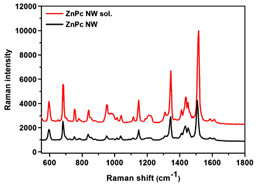亜鉛フタロシアニンナノワイヤーの水分散性の顕著な向上およびがんの光線療法への応用
Significant increase in the water dispersibility of zinc phthalocyanine nanowires and applications in cancer phototherapy.
2012年4月13日 NPG Asia Materials 4, e4 (2012) doi:10.1038/am.2012.22
光増感剤:水中に分散するナノワイヤー

Hee Cheul ChoiおよびSang Ho Leeの研究チームはこのたび、光感受性分子の水中での分散性を向上させる方法を考案した。光を利用した腫瘍などの疾患の治療方法では、ほかの方法よりも侵襲性と毒性を低くすることが可能だ。そうした光線力学治療や光熱治療では、光照射によって励起されると活性酸素種や熱を放出して標的細胞を破壊する光感受性分子(光増感剤)が利用されるのだが、ほとんどの光増感剤は生理水溶液に溶けにくいため、人体への応用が阻まれている。研究チームは今回、そうした光感受性分子の1つである亜鉛フタロシアニン(中央の孔に亜鉛原子を持つ大環状合物)について、化学組成を変えるのではなく粉末を結晶ナノワイヤーに変えることによって、著しく水分散性が向上することを見いだした。このナノワイヤーはまた、光線力学治療と光熱治療のいずれの応用にも有望であることが判明した。
Photo-sensitizers: Nanowires dispersed in water
Hee Cheul Choi, Sang Ho Lee and co-workers have devised a way to improve the dispersibility of light-sensitive molecules in water. Using light to treat medical conditions, including tumours, can be less invasive and toxic than other approaches. Such photodynamic and photothermal therapies rely on a light-sensitive molecule — a photo-sensitizer — that is excited under irradiation to release either reactive oxygen species or heat, respectively, which in turn can destroy targeted cells. Most photo-sensitizers, however, suffer from poor solubility in aqueous physiological media, which hinders their applications in the body. This is the case for zinc phthalocyanine, a macrocyclic compound hosting a zinc atom in its central cavity. Rather than trying to alter its chemical composition, the researchers have now observed that converting the powder form into crystalline nanowires significantly increased its dispersibility in water. Furthermore, the nanowires were found to be promising for both photothermal and photodynamic therapies.

